Abstract
The internal ear's sensory receptor, or hair cell, responds when stimuli deflect its mechanoreceptive hair bundle. As a hair cell adapts to sustained stimulation, mechanical adjustments within the bundle reset its position of sensitivity. Because several lines of experimentation suggest that a form of myosin I mediates adaptation, we endeavored to clone cDNAs encoding this motor molecule. By using degenerate oligonucleotide primers based upon the deduced amino acid sequence for mammalian myosin I beta, we performed reverse transcription and polymerase chain reactions (PCRs) to produce a candidate cDNA from polyadenylylated mRNA isolated from the frog's brain. The resultant product was used to probe a cDNA library, from which were isolated clones encoding an approximately 119-kDa isozyme of myosin I beta. PCR amplification disclosed the presence of mRNA encoding the same isozyme in tissue from the bullfrog's sacculus, an organ of the internal ear. When expressed as a bacterial fusion protein, a domain from the tail region of this form of myosin I was recognized by monoclonal antibodies that react with myosin I in hair bundles. This cloned approximately 119-kDa isozyme of myosin I is accordingly a candidate to be the motor molecule responsible for the adaptation of mechanoelectrical transduction by hair cells.
Full text
PDF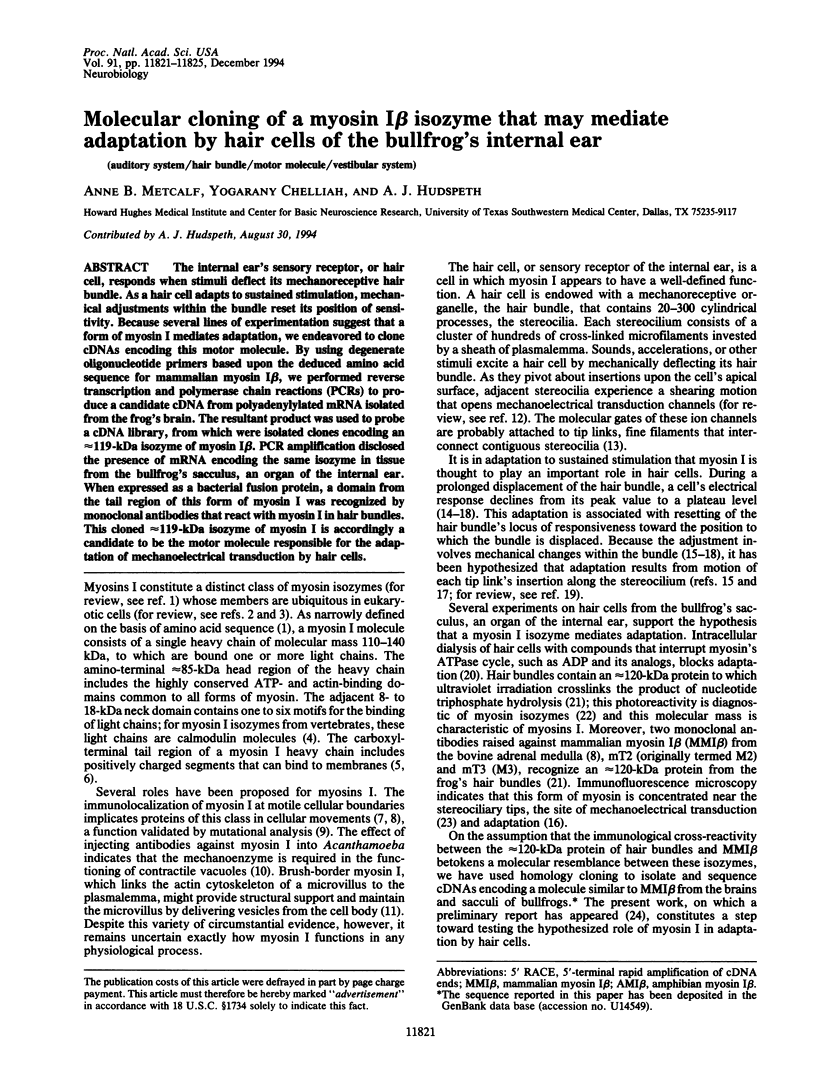
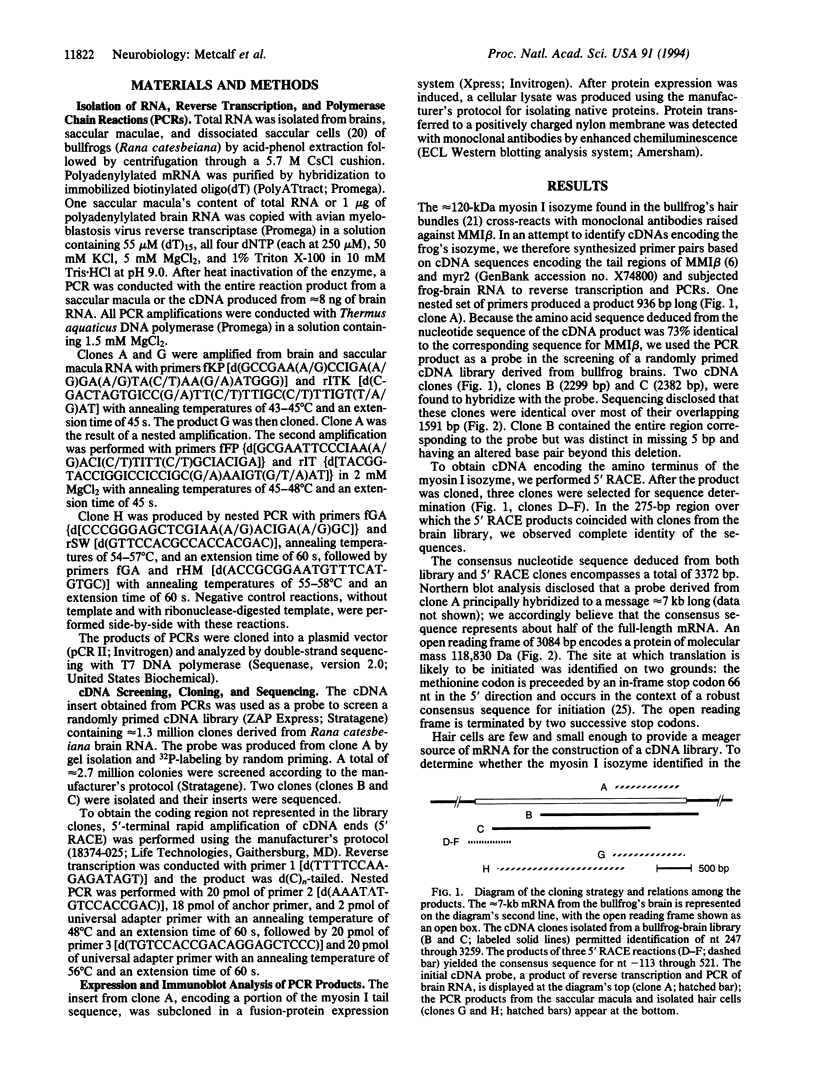
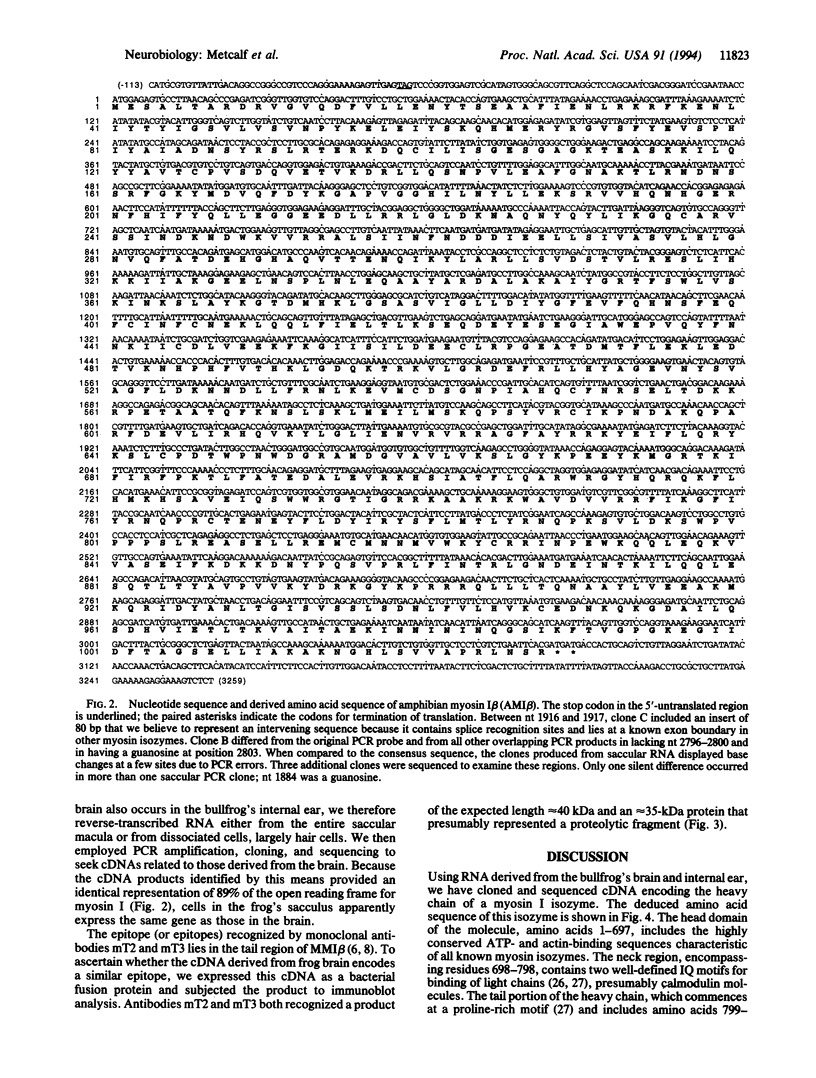
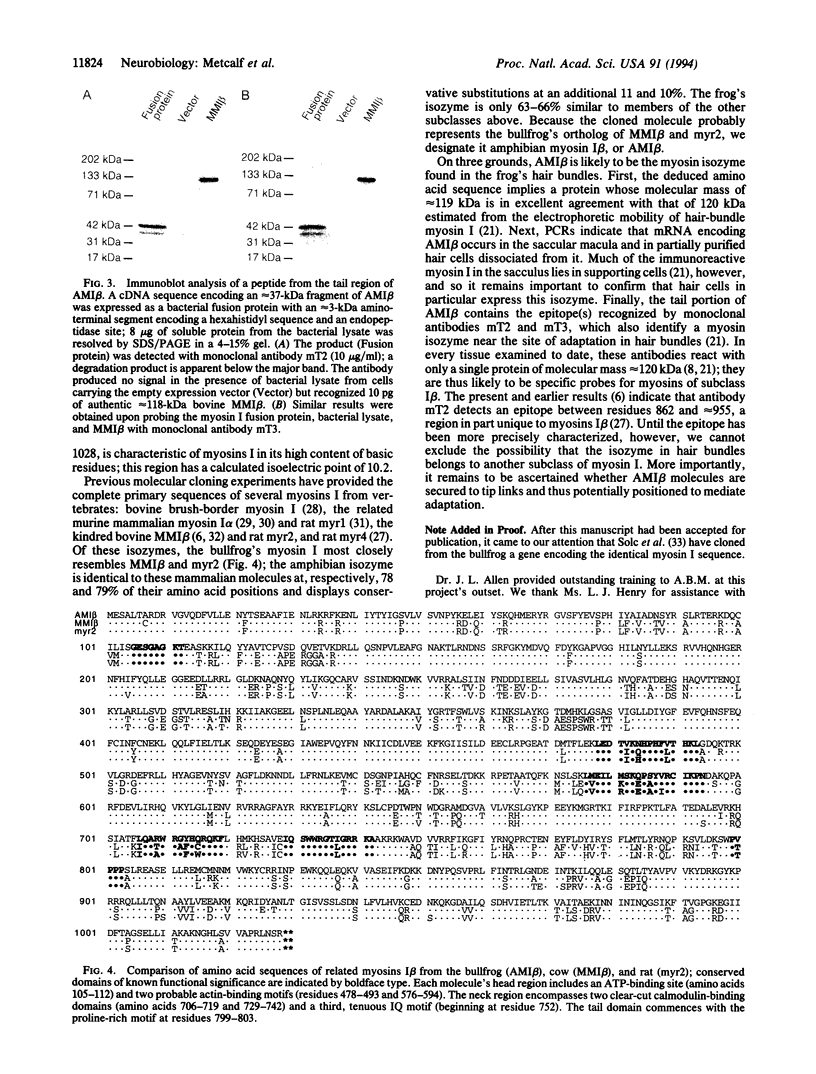
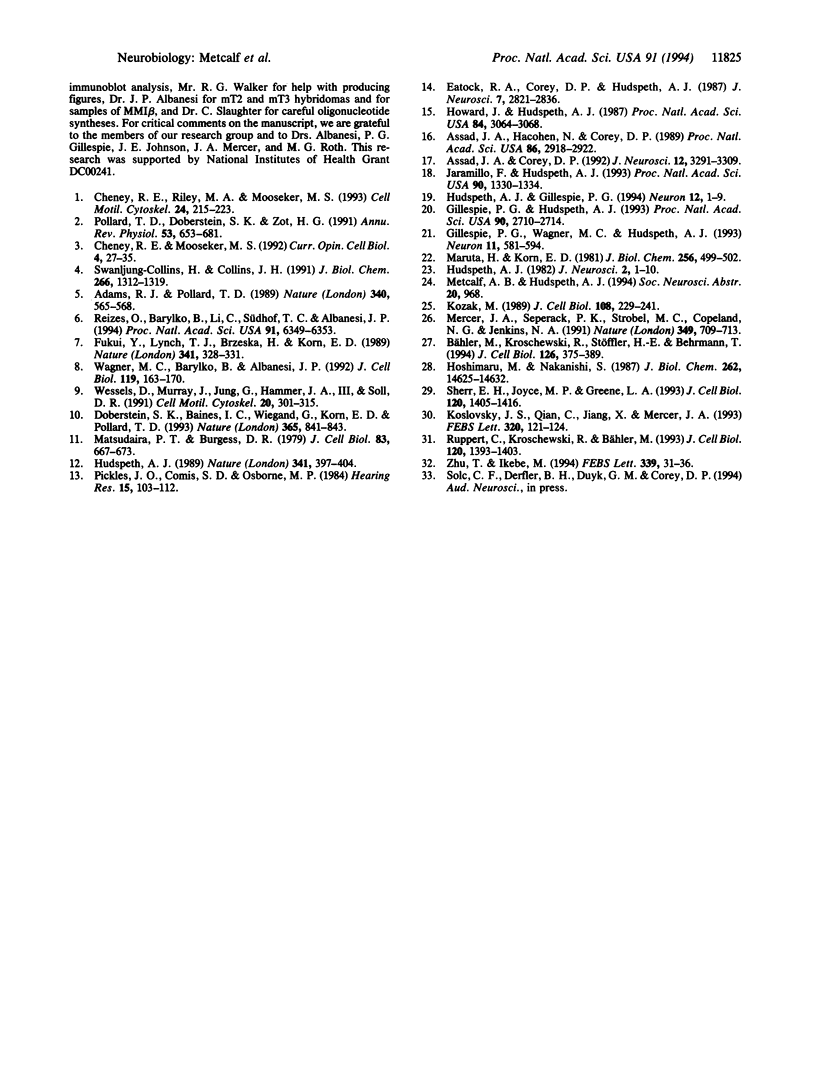
Images in this article
Selected References
These references are in PubMed. This may not be the complete list of references from this article.
- Adams R. J., Pollard T. D. Binding of myosin I to membrane lipids. Nature. 1989 Aug 17;340(6234):565–568. doi: 10.1038/340565a0. [DOI] [PubMed] [Google Scholar]
- Assad J. A., Corey D. P. An active motor model for adaptation by vertebrate hair cells. J Neurosci. 1992 Sep;12(9):3291–3309. doi: 10.1523/JNEUROSCI.12-09-03291.1992. [DOI] [PMC free article] [PubMed] [Google Scholar]
- Assad J. A., Hacohen N., Corey D. P. Voltage dependence of adaptation and active bundle movement in bullfrog saccular hair cells. Proc Natl Acad Sci U S A. 1989 Apr;86(8):2918–2922. doi: 10.1073/pnas.86.8.2918. [DOI] [PMC free article] [PubMed] [Google Scholar]
- Bähler M., Kroschewski R., Stöffler H. E., Behrmann T. Rat myr 4 defines a novel subclass of myosin I: identification, distribution, localization, and mapping of calmodulin-binding sites with differential calcium sensitivity. J Cell Biol. 1994 Jul;126(2):375–389. doi: 10.1083/jcb.126.2.375. [DOI] [PMC free article] [PubMed] [Google Scholar]
- Cheney R. E., Mooseker M. S. Unconventional myosins. Curr Opin Cell Biol. 1992 Feb;4(1):27–35. doi: 10.1016/0955-0674(92)90055-h. [DOI] [PubMed] [Google Scholar]
- Cheney R. E., Riley M. A., Mooseker M. S. Phylogenetic analysis of the myosin superfamily. Cell Motil Cytoskeleton. 1993;24(4):215–223. doi: 10.1002/cm.970240402. [DOI] [PubMed] [Google Scholar]
- Doberstein S. K., Baines I. C., Wiegand G., Korn E. D., Pollard T. D. Inhibition of contractile vacuole function in vivo by antibodies against myosin-I. Nature. 1993 Oct 28;365(6449):841–843. doi: 10.1038/365841a0. [DOI] [PubMed] [Google Scholar]
- Eatock R. A., Corey D. P., Hudspeth A. J. Adaptation of mechanoelectrical transduction in hair cells of the bullfrog's sacculus. J Neurosci. 1987 Sep;7(9):2821–2836. doi: 10.1523/JNEUROSCI.07-09-02821.1987. [DOI] [PMC free article] [PubMed] [Google Scholar]
- Fukui Y., Lynch T. J., Brzeska H., Korn E. D. Myosin I is located at the leading edges of locomoting Dictyostelium amoebae. Nature. 1989 Sep 28;341(6240):328–331. doi: 10.1038/341328a0. [DOI] [PubMed] [Google Scholar]
- Gillespie P. G., Hudspeth A. J. Adenine nucleoside diphosphates block adaptation of mechanoelectrical transduction in hair cells. Proc Natl Acad Sci U S A. 1993 Apr 1;90(7):2710–2714. doi: 10.1073/pnas.90.7.2710. [DOI] [PMC free article] [PubMed] [Google Scholar]
- Gillespie P. G., Wagner M. C., Hudspeth A. J. Identification of a 120 kd hair-bundle myosin located near stereociliary tips. Neuron. 1993 Oct;11(4):581–594. doi: 10.1016/0896-6273(93)90071-x. [DOI] [PubMed] [Google Scholar]
- Hoshimaru M., Nakanishi S. Identification of a new type of mammalian myosin heavy chain by molecular cloning. Overlap of its mRNA with preprotachykinin B mRNA. J Biol Chem. 1987 Oct 25;262(30):14625–14632. [PubMed] [Google Scholar]
- Howard J., Hudspeth A. J. Mechanical relaxation of the hair bundle mediates adaptation in mechanoelectrical transduction by the bullfrog's saccular hair cell. Proc Natl Acad Sci U S A. 1987 May;84(9):3064–3068. doi: 10.1073/pnas.84.9.3064. [DOI] [PMC free article] [PubMed] [Google Scholar]
- Hudspeth A. J. Extracellular current flow and the site of transduction by vertebrate hair cells. J Neurosci. 1982 Jan;2(1):1–10. doi: 10.1523/JNEUROSCI.02-01-00001.1982. [DOI] [PMC free article] [PubMed] [Google Scholar]
- Hudspeth A. J., Gillespie P. G. Pulling springs to tune transduction: adaptation by hair cells. Neuron. 1994 Jan;12(1):1–9. doi: 10.1016/0896-6273(94)90147-3. [DOI] [PubMed] [Google Scholar]
- Hudspeth A. J. How the ear's works work. Nature. 1989 Oct 5;341(6241):397–404. doi: 10.1038/341397a0. [DOI] [PubMed] [Google Scholar]
- Jaramillo F., Hudspeth A. J. Displacement-clamp measurement of the forces exerted by gating springs in the hair bundle. Proc Natl Acad Sci U S A. 1993 Feb 15;90(4):1330–1334. doi: 10.1073/pnas.90.4.1330. [DOI] [PMC free article] [PubMed] [Google Scholar]
- Koslovsky J. S., Qian C., Jiang X., Mercer J. A. Molecular cloning of a mouse myosin I expressed in brain. FEBS Lett. 1993 Apr 5;320(2):121–124. doi: 10.1016/0014-5793(93)80075-6. [DOI] [PubMed] [Google Scholar]
- Kozak M. The scanning model for translation: an update. J Cell Biol. 1989 Feb;108(2):229–241. doi: 10.1083/jcb.108.2.229. [DOI] [PMC free article] [PubMed] [Google Scholar]
- Maruta H., Korn E. D. Direct photoaffinity labeling by nucleotides of the apparent catalytic site on the heavy chains of smooth muscle and Acanthamoeba myosins. J Biol Chem. 1981 Jan 10;256(1):499–502. [PubMed] [Google Scholar]
- Matsudaira P. T., Burgess D. R. Identification and organization of the components in the isolated microvillus cytoskeleton. J Cell Biol. 1979 Dec;83(3):667–673. doi: 10.1083/jcb.83.3.667. [DOI] [PMC free article] [PubMed] [Google Scholar]
- Mercer J. A., Seperack P. K., Strobel M. C., Copeland N. G., Jenkins N. A. Novel myosin heavy chain encoded by murine dilute coat colour locus. Nature. 1991 Feb 21;349(6311):709–713. doi: 10.1038/349709a0. [DOI] [PubMed] [Google Scholar]
- Pickles J. O., Comis S. D., Osborne M. P. Cross-links between stereocilia in the guinea pig organ of Corti, and their possible relation to sensory transduction. Hear Res. 1984 Aug;15(2):103–112. doi: 10.1016/0378-5955(84)90041-8. [DOI] [PubMed] [Google Scholar]
- Pollard T. D., Doberstein S. K., Zot H. G. Myosin-I. Annu Rev Physiol. 1991;53:653–681. doi: 10.1146/annurev.ph.53.030191.003253. [DOI] [PubMed] [Google Scholar]
- Reizes O., Barylko B., Li C., Südhof T. C., Albanesi J. P. Domain structure of a mammalian myosin I beta. Proc Natl Acad Sci U S A. 1994 Jul 5;91(14):6349–6353. doi: 10.1073/pnas.91.14.6349. [DOI] [PMC free article] [PubMed] [Google Scholar]
- Ruppert C., Kroschewski R., Bähler M. Identification, characterization and cloning of myr 1, a mammalian myosin-I. J Cell Biol. 1993 Mar;120(6):1393–1403. doi: 10.1083/jcb.120.6.1393. [DOI] [PMC free article] [PubMed] [Google Scholar]
- Sherr E. H., Joyce M. P., Greene L. A. Mammalian myosin I alpha, I beta, and I gamma: new widely expressed genes of the myosin I family. J Cell Biol. 1993 Mar;120(6):1405–1416. doi: 10.1083/jcb.120.6.1405. [DOI] [PMC free article] [PubMed] [Google Scholar]
- Swanljung-Collins H., Collins J. H. Ca2+ stimulates the Mg2(+)-ATPase activity of brush border myosin I with three or four calmodulin light chains but inhibits with less than two bound. J Biol Chem. 1991 Jan 15;266(2):1312–1319. [PubMed] [Google Scholar]
- Wagner M. C., Barylko B., Albanesi J. P. Tissue distribution and subcellular localization of mammalian myosin I. J Cell Biol. 1992 Oct;119(1):163–170. doi: 10.1083/jcb.119.1.163. [DOI] [PMC free article] [PubMed] [Google Scholar]
- Wessels D., Murray J., Jung G., Hammer J. A., 3rd, Soll D. R. Myosin IB null mutants of Dictyostelium exhibit abnormalities in motility. Cell Motil Cytoskeleton. 1991;20(4):301–315. doi: 10.1002/cm.970200406. [DOI] [PubMed] [Google Scholar]
- Zhu T., Ikebe M. A novel myosin I from bovine adrenal gland. FEBS Lett. 1994 Feb 14;339(1-2):31–36. doi: 10.1016/0014-5793(94)80378-1. [DOI] [PubMed] [Google Scholar]



